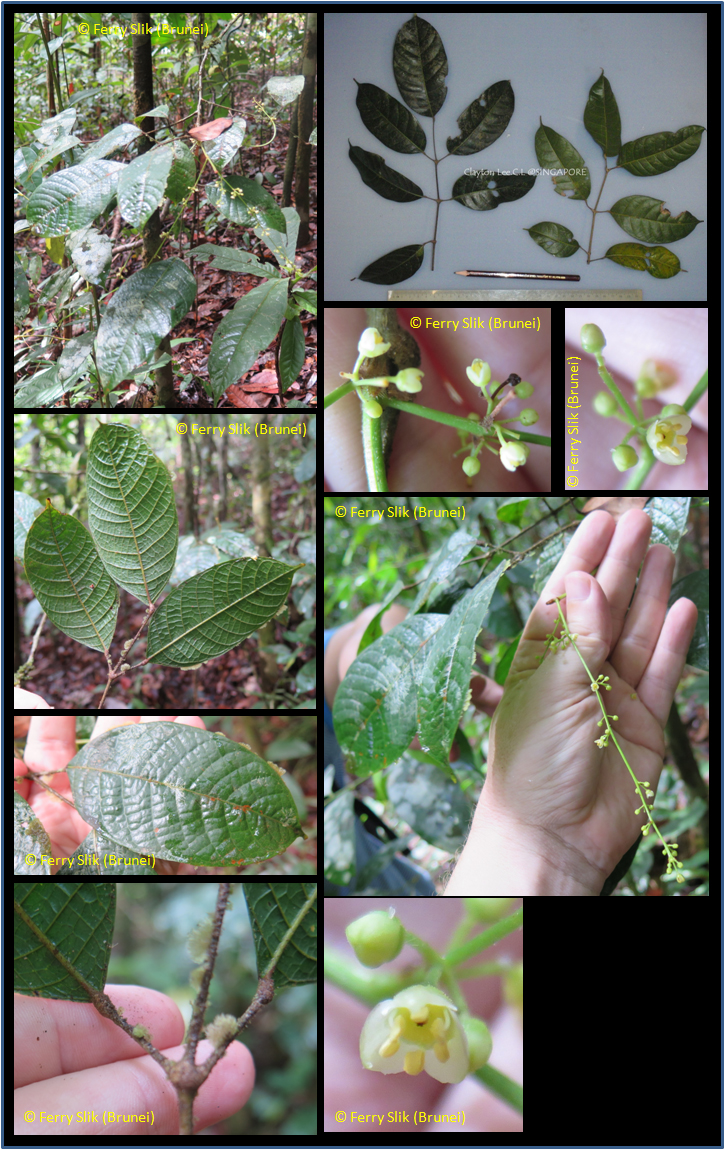Dacryodes rugosa (Bl.) H.J. Lam, Ann. Jard. Bot. Btzg. 42 (1932)
Latin for 'wrinkled', referring to the dried fruits.Synonyms
Canarium moultonii Ridl.
Canarium rugosum Miq.
Canarium rugosum var. sumatranum Miq.
Canarium virgatum Miq.
Hemisantiria rugosa H.J. Lam
Santiria fasciculata Benn. in Hook.f.
Santiria longepaniculata Baker
Santiria rugosa Bl.
Santiria virgata Bl.
Diagnostics
Mid-canopy tree up to 37 m tall and 42 cm dbh. Leaves alternate, compound,
penni-veined, petioles strongly swollen at base and tip, petioles usually quite long and mostly glabrous.
Flowers ca. 1.4 mm in diameter, yellowish-white, placed in panicles. Fruits ca.
17 mm long, yellow-orange-red, fleshy drupes.
Description
Tree 5-20(-37) m tall by 8-40(-100) cm diameter, sometimes a large shrub; no buttresses. Branchlets 3-5 mm
thick, smooth, long remaining pubescent; pith without vascular strands. Leaves (0-)2-4-jugate.
Petioles terete to +/- flattened at base, 3-9.5 cm, pubescent or puberulous to glabrous, pith with
1 or few, rarely without vascular strands; base of the petiole, nodes of the rhachis, and ends of the
petiolules distinctly swollen. Leaflets obovate or ovate to oblong-lanceolate, 6-22 by 2.5-ll cm,
chartaceous, often bullate; indumentum variable; base oblique, cuneate to rounded; apex more or
less abruptly acuminate, acumen 0.5-3.5 cm by 1-3 mm, often slightly broadened at the tip, blunt;
nervation usually distinctly prominent beneath, nerves 7-12 pairs (angle 50-80 degrees), slightly curved,
often arching near the margin. Panicles axillary, together pseudoterminal, rarely terminal, densely
and minutely pubescent, male slender, 15-60 cm long, laxly branched from the base, branches up to 25
cm long, flowers usually clustered; female ones pyramidal, lax and relatively few-flowered, 2-25(-40)
cm, peduncle 0-4 cm, branches up to 9 cm long. Flowers 1.5-2.5 mm, sparsely pubescent to
glabrous. Calyx in male flowers 0.75-l mm, in female ones 1-1.5 mm. Stamens adnate to the disk,
episepalous ones slightly longer. Disk cupular, thick. Pistil in male flowers moderately to entirely
reduced. Fruits ovoid, slightly oblique, 1.5-2.5 by 0.75-1.5 cm, rounded at both ends; flower remains
long persistent. Cotyledons consisting of 3 separate, petioluled lobes, contortuplicate. [from Flora
Malesiana]
Ecology
In undisturbed forests up to 900 m altitude. Usually on hillsides and ridges
in mixed dipterocarp forest, occasionally in swamps or in keranga forest.
Distribution
Peninsular Malaysia, Sumatra, Java, Borneo.
Uses
Timber is used, but of little value.
Local names
Borneo: Dayau, Kambayu burong, Kedongdong, Kemanyan, Langsat burung, Maram putis,
Owas-owas, Paninasan burong, Patiu, Pitong kalaout, Punan ratjang, Sare djani,
Seladah, Talang sai, Tompulan, Tuli, Tunying, Tutut, Watuk.
Malaysia: kedondong, kedongdong bulau puteh, kedongdong mata hari, leletup.
Sumatra: gita tjilok, kabau, kaju manan, kaju napo, rihil.
